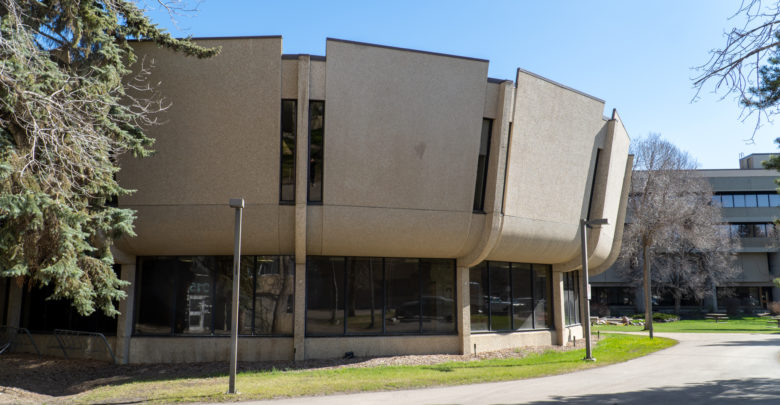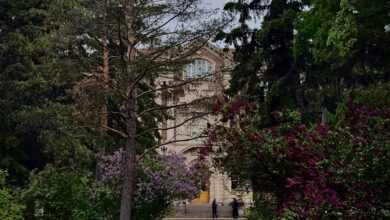Humanities Centre closed for winter semester due to electrical fire
Facilities and Operations found they need to "conduct more extensive restoration than we had anticipated."
 Martin Bendico
Martin BendicoAs a result of an electrical vault fire that occurred during the fall semester exam break, the Humanities Centre (HC) has been shut down for the entirety of the winter semester.
On December 18, the University of Alberta released a statement announcing the temporary closure of the HC. On January 4, the U of A announced the building would be closed for all of winter semester. As well, they said they were working on relocating all affected classes.
James Allen, vice-president (facilities and operations), said the fire was not large but there was a significant amount of smoke. Allen said in the days after the fire, he and his team worked to establish a temporary power feed. On December 22, a restoration company began cleanup. As well, they conducted air quality testing and tested for contaminants.
On January 2, Allen and his team received the results of the testing. According to the statement released January 4, the “Air Quality Report and the Restoration Assessment found this contamination poses an air quality health and safety risk.”
“After we reviewed the findings of that test, [we found] that we needed to conduct more extensive restoration than we had anticipated. Which included addressing the widespread contamination,” Allen said.
“Our priority has been focused on minimizing impact to our students and it’s looking quite good,” Allen says
According to Allen, the Registrar’s Office is focusing on limiting impacts to students, faculty, and staff. Currently, the Registrar’s Office and relevant faculties are working to find alternative classrooms, he said. According to Allen, they have already found suitable classrooms for the majority of classes. At the time of the interview, Allen did not know of any rescheduled classes. As well, he said the Registrar’s Office was taking into account travel distance.
“Our priority has been focused on minimizing impact to our students and it’s looking quite good.”
Students will learn the location of their classes through BearTracks before the semester begins, Allen said.
Still, finding temporary workplaces for faculty and staff will likely take a few weeks, Allen said. For that time, there will “be a degree of working from home.”
U of A anticipates having $1 billion in deferred maintenance liability by 2025
The U of A anticipates that by 2025, they will have deferred maintenance liability of more than $1 billion. Deferred work orders are work orders that have been open for longer than a year. Often, this is because they do not meet triage criteria.
With the resources allocated to them by the university and government, Facilities and Operations address the highest priority issues first, Allen said. As of September 2023, the end of their fiscal year, there were 2,517 open work orders. This included 340 deferred work orders.
According to information from February 2023, the HC has a total of $7.9 million in deferred maintenance. For electrical work, this number is $0.5 million.
Additionally, The National Trust, a charity that works to save heritage buildings, has placed the HC on its Endangered Places List. As a part of their integrated asset management strategy, the university has plans to reduce its physical footprint by 30 per cent. This includes removing the HC. In their list, The National Trust criticized the university for “its desire to remove deferred maintenance liability.”
The Gateway reached out to the Organization for Arts Students and Interdisciplinary Studies (OASIS), but they didn’t respond in time for comment. However, Nathan Perez, vice-president (outreach and events) of OASIS, posted on his personal Instagram about the closure. OASIS operates primarily out of their office which is in the HC. In the post, Perez criticized the universities’ plan to remove “underfunded and ageing buildings” in the interest of reducing operational costs.
“Deferred maintenance on campus continues to negatively affect the delivery of education and quality of experience for the student populace. Sadly, actions that could preserve these spaces for both students and faculty are overlooked in place of economising measures.”
Deferred maintenance not the cause of the fire, Allen says
Allen does not think deferred maintenance was the cause of the fire.
“We have new equipment that can fail, we have middle-aged equipment, and we have some that have passed their life cycle that have been incredibly well-maintained. In this case, we do have robust preventive maintenance programs,” Allen said.
“I’d be confident saying that one cannot point directly to deferred maintenance to say that was the cause of this equipment failure.”
As well, due to the size of North Campus, Allen said deferred maintenance is normal. At this time, Allen said he is not aware of any risks of similar electrical fires.
“We’re not aware of any imminent risks of other [fires], but we do have a plan to renew our vaults. We try to get a couple of those every year.”
UPDATE: On January 8 at 1:41 p.m., this article was updated to include that Nathan Perez posted a statement on his personal Instagram, not on behalf of OASIS.



